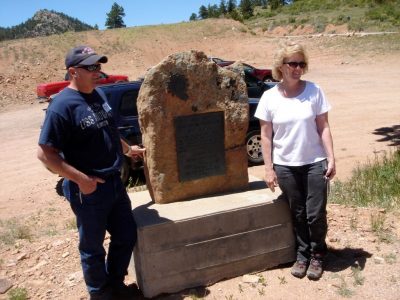Log Cabin, 1888-1942, was a stage station, post office, store and hotel on the route from Fort Collins to Home, Colorado, in the upper reaches of the Poudre River Canyon. The route went by way of LaPorte, Bellvue, Ingleside, Owl Canyon, the Forks Hotel, and Livermore to Log Cabin, proceeding southwest from there to Elkhorn and Manhattan, and down the steep and precipitous trail on Pingree Hill to the Rustic Hotel at the foot of the Hill, and thence up Poudre Canyon to Home, Colorado, also known as Zimmerman’s and the Keystone Hotel.
In 1888, Mrs. Elizabeth St. Clair homesteaded 320 acres at the Log Cabin site, moving a log dwelling there from Ashley Grange to the southwest. Ashley Grange was a school established in the early days in the Elkhorn area by a wealthy Englishman to teach ranching to English boys. The Grange was named for the English manor home of one of the owners, a Mr. Halliday.
When the road from Livermore to the upper Poudre was changed in 1896 from the Elkhorn Creek route to the Pingree Hill route, Mrs. St. Clair called her place the Log Cabin Hotel, and with two sons by a former marriage, Vern and Roy Williams, she ran a stage stop, store and hotel. Later, in 1903, it became an official United States Post Office.
It was mainly a stage stop, a place for passengers and crew to eat and rest and for the drivers to pick up fresh horses. The main building stood on the north side of the road that went down Pingree Hill to the Rustic Hotel, on the Poudre River. On the south side of the road were a barn and some sheds. The original post office was a little log building to the west of the main building.
The early stages were drawn by horses. Later, when Casper Zimmerman was manager of the stage line, steam automobiles were used to Log Cabin or Elkhorn, where mail, passengers, and freight were transferred to horse-drawn vehicles.
In the 1920s, the line went to cars with large wheels that could travel the muddy roads.
In 1910, Mrs. St. Clair sold the Log Cabin property to Stewart C. Case, who became postmaster and ran the store and hotel. In addition, he was teacher at the Log Cabin School. The school is still standing in its original location on the north side of the road east of the intersection. It is now a private dwelling.
Mr. Case’s father, Albert H. Case, had been an early homesteader on Black Mountain near Red Feather. The Cases had three sons, Bayard, Lee, and Ivan, who helped “team” and run the business.
In 1919, the Cases sold Log Cabin to Appleton E. Worster. Later in 1919, he traded Log Cabin to Mr. and Mrs. Willis S. Miller for their property at Elkhorn, where they had been postmasters. Mr. Miller had filed on his homestead at Elkhorn in 1901, and subsequently established a store, hotel, and restaurant along with the post office.
At Log Cabin, they continued their work and enlarged it. They built some small over-night cabins on the north side of the road, and a dance hall on the south side, east of the big barn.
The Miller children – six “Miller boys” and three daughters: Allie, Myrtle, and Frieda – were all involved in the place at Log Cabin.
While they were there, Frieda married Jess Scott, who with his brother Ben, ran the stage line for many years. The “Scott Brothers” brought mail, passengers, and freight to this mountain land regardless of weather, often “breaking the road” for other travelers.
It was while the Miller family “ran” Log Cabin that my mother, then Mildred Payson Lambe and later Mrs. Ben Beatty, taught at the West Lake School on the Hardin Ranch near Red Feather Lakes. In her first year there in 1925-26, she boarded in turn with each of the three school board members – Martin Peterson, Will Hardin, and John Wagner.
Each Friday afternoon, she would ride a horse to Log Cabin, leave the horse there, get in her 1920’s Chevrolet touring car with button down canvas-and-isinglass curtains, and drive to Fort Collins, where my brother and I stayed with my grandparents.
On Sunday afternoon, she would drive back to Log Cabin, pick up the horse which had been stabled there, and return to the ranch where she had been staying.
In 1928, the Millers sold to Rosetta L. Van Sickle, who was the mother of Myrtle Miller’s husband, Joe Geiger.
In November, 1931, the old original building caught fire and burned to the ground. It was never rebuilt.
The post office was continued until 1942 when it was closed.
Mrs. Van Sickle sold to George Weaver in 1942, and until 1959, the land was part of his Pinecroft Ranch. In 1959, Mr. Weaver’s ranch was purchased by Ben Delatour of Fort Collins and donated to the Boy Scouts of America to become the Boy Scout Ranch which it is today. Frank and Norma Bennett, who are Jess and Frieda Scott’s daughter and son in law, have a mobile home at the spring which furnished water for old Log Cabin on the hill northwest of the Log Cabin site.
For more than 50 years, Log Cabin was run and maintained by the St. Clairs, the Case family, the Miller family, Ap and Myra Worster, and the Van Sickle and Geiger families. Though time erased the name of Log Cabin, the contribution of these families, in service, faith, and joy of living, to life in this beautiful mountain land, lives on.
Postmasters:
Elizabeth St. Clair: January 1903
Stewart Case: November 1911
Myra Worster: March 1919
Willis S. Miller: December 1919
Jim Geiger: July 1928
Cord M. Geiger: January 1932
David Graves: June 1937
William R. Collette: June 1938
— Closed in 1942 —
From material collected by Mr. and Mrs. Lafi Miller.
